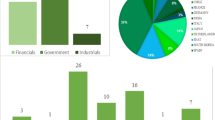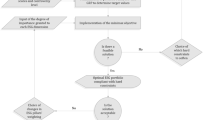Abstract
A detailed analysis of the Least Squares Monte-Carlo (LSM) approach to American option valuation suggested in Longstaff and Schwartz (2001) is performed. We compare the specification of the cross-sectional regressions with Laguerre polynomials used in Longstaff and Schwartz (2001) with alternative specifications and show that some of these have numerically better properties. Furthermore, each of these specifications leads to a trade-off between the time used to calculate a price and the precision of that price. Comparing the method-specific trade-offs reveals that a modified specification using ordinary monomials is preferred over the specification based on Laguerre polynomials. Next, we generalize the pricing problem by considering options on multiple assets and we show that the LSM method can be implemented easily for dimensions as high as ten or more. Furthermore, we show that the LSM method is computationally more efficient than existing numerical methods. In particular, when the number of assets is high, say five, Finite Difference methods are infeasible, and we show that our modified LSM method is superior to the Binomial Model.
Similar content being viewed by others
References
Amin, K.I. (1991). “On the Computation of Continuous Time Option Prices Using Discrete Approximations,” Journal of Financial and Quantitative Analysis 26, 477-495.
Barraquand, J. (1995). “Numerical Valuation of High Dimensional Multivariate European Securities,” Management Science 41(12), 1882-1891.
Barraquand, J. and D. Martineau. (1995). “Numerical Valuation of High Dimensional Multivariate American Securities,” Journal of Financial and Quantitative Analysis 30, 383-405.
Black, F. and M. Scholes. (1973). “The Pricing of Options and Corporate Liabilities,” Journal of Political Economy 81, 637-654.
Boyle, P.P. (1977). “Options: A Monte Carlo Approach,” Journal of Financial Economics 4, 323-338.
Boyle, P.P. (1988). “A Lattice Framework for Option Pricing with Two State Variables,” Journal of Financial and Quantitative Analysis 23, 1-12.
Boyle, P.P., M. Broadie, and P. Glasserman. (1997). “Monte Carlo Methods for Security Pricing,” Journal of Economic Dynamics and Control 21, 1267-1321.
Boyle, P.P., J. Evnine, and S. Gibbs. (1989). “Numerical Evaluation of Multivariate Contingent Claims,” Review of Financial Studies 2, 241-250.
Boyle, P.P. and Y.K. Tse. (1990). “An Algorithm for Computing Values of Options on the Maximum or Minimum of Several Assets,” Journal of Financial and Quantitative Analysis 25, 215-227.
Broadie, M. and J. Detemple. (1996). “American Option Valuation: New Bounds, Approximations, and a Comparison of Existing Methods,” Review of Financial Studies 9, 1211-1250.
Broadie, M. and P. Glasserman. (1997). “Pricing American-Style Securities Using Simulation,” Journal of Economic Dynamics and Control 21, 1323-1352.
Campbell, J., A. Lo, and C. MacKinlay. (1996). The Econometrics of Financial Markets. Princeton, NJ: Princeton University Press.
Carr, P. (1998). “Randomization and the American Put,” Review of Financial Studies 11, 597-626.
Carriere, J.F. (1996). “Valuation of the Early-Exercise Price for Options Using Simulations and Nonparametric Regression,” Insurance: Mathematics and Economics 19, 19-30.
Cox, J., S. Ross, and M. Rubinstein. (1979). “Option Pricing: A Simplified Approach,” Journal of Financial Economics 7, 229-264.
Doornik, J.A. (2001). Ox: An Object-Oriented Matrix Language, 4th ed. London: Timberlake Consultants Press.
Hull, J.C. (1997). Options, Futures, and Other Derivatives. New Jersey: Prentice Hall.
Johnson, H. (1987). “Options on the Maximum or the Minimum of Several Assets,” Journal of Financial and Quantitative Analysis 22, 277-283.
Judd, K.L. (1998). Numerical Methods in Economics. Cambridge, MA: MIT.
Kloeden, P.E., E. Platen, and H. Schurz. (1994). Numerical Solutions of SDE Through Computer Experiments. Berlin: Springer.
Longstaff, F.A. and E.S. Schwartz. (2001). “Valuing American Options by Simulation: A Simple Least-Squares Approach,” Review of Financial Studies 14, 113-147.
Press, W.H., S.A. Teukolsky, W.T. Vetterling, and B.P. Flannery. (1997). Numerical Recipies in C: The Art of Scientific Computing. Cambridge: Cambridge University Press.
Royden, H.L. (1988). Real Analysis. New Jersey: Prentice Hall.
Tilley, J.A. (1993). “Valuing American Options in a Path Simulation Model,” Transactions, Society of Actuaries, Schaumburg 45, 499-520.
Author information
Authors and Affiliations
Rights and permissions
About this article
Cite this article
Stentoft, L. Assessing the Least Squares Monte-Carlo Approach to American Option Valuation. Review of Derivatives Research 7, 129–168 (2004). https://doi.org/10.1023/B:REDR.0000031176.24759.e6
Issue Date:
DOI: https://doi.org/10.1023/B:REDR.0000031176.24759.e6




